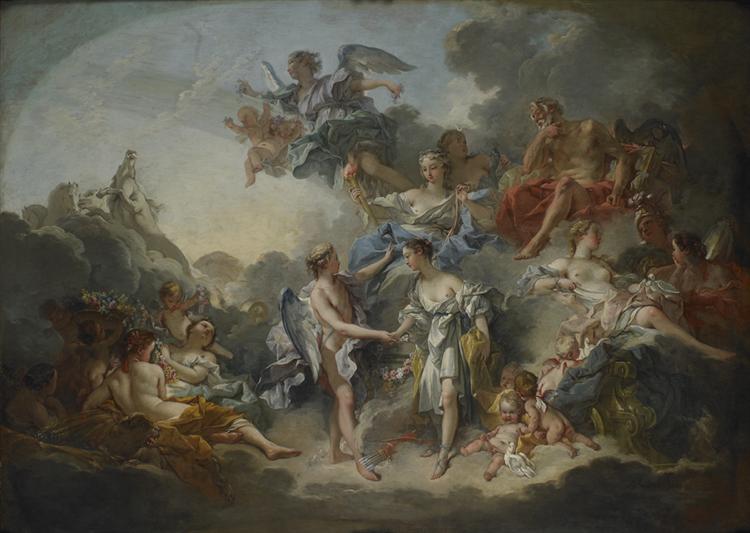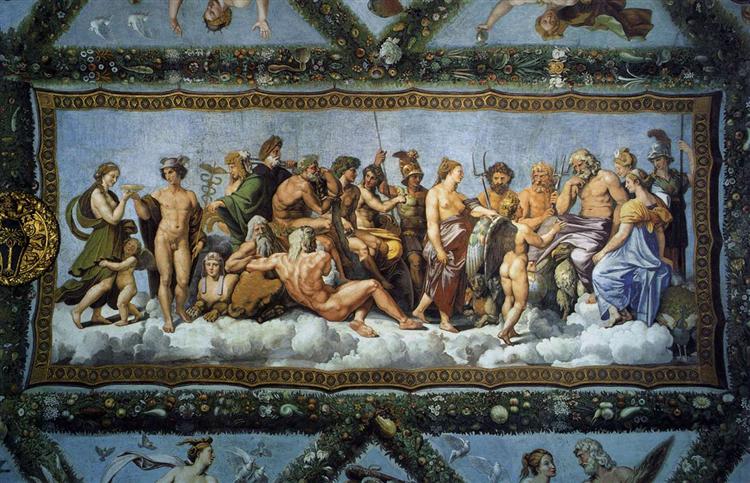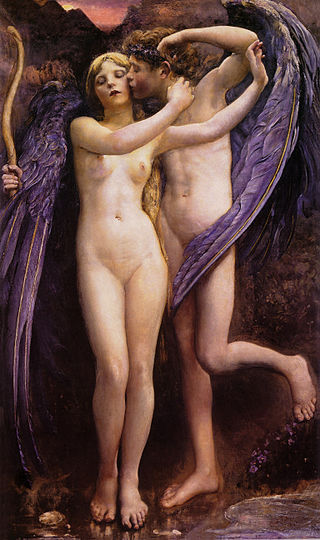The story of Psyche and Eros is probably one of the most beautiful of Greek mythology. It has been told several times, serving as inspiration to many artists of the past. And even in our days it keeps its magic, as a common archetype in several movies.

Psyche was a mortal woman, her extreme grace and beauty made her famous, there was no person in the world that didn’t want to meet her. Because of her love and sacrifice for Eros (Cupid in Roman Mythology) she earned the immortality. As “psyche” is the Greek name for “soul” or “spirit”, Psyche became the deity of soul and nowadays her myth is understood as a self-search and personal growth through learning, losing and saving the real love.
The Story
“There was a king, however where he ruled and what his name is unknown, but nevertheless he had a daughter named Psyche. Her beauty was famed everywhere, and men flocked to admire and pay homage to her. The jealousy of Aphrodite was subsequently induced, and she called for Eros to pierce Psyche with an arrow so that Psyche may fall in love with the vilest man on Earth. Eros was unable to follow through with Aphrodite’s command as he himself fell in love with Psyche.

(Manchester Art Gallery)
Despite being spared from Aphrodite’s wrath, Psyche still suffered, as no man was willing to marry her. Psyche’s father travelled to the Oracle at Delphi in desperation to ask why his daughter was seemingly unfit for marriage despite her great beauty. The words of the Oracle revealed that Psyche’s future husband was a fearful creature of sorts, and that Psyche must be left alone on a rocky hilltop. The father obliged to the instructions.
Alone on the hill, the wind Zephyr gently lifted Psyche and brought her to a meadow with a small estate that was waiting for Psyche to inhabit it. Psyche lived here with servants whom she could not see and only hear. She was informed that this arrangement was the work of her destined husband; like the servants, Psyche could hear and talk to him but was forbidden to look upon him. Human curiosity eventually got the better of Psyche, and when her sisters came to visit the estate one day, Psyche begged them for advice on how to sneak a look at her husband.
One night, Psyche (per instruction of her sisters) took an oil lamp and snuck into her husband’s chamber while he slept. Who she saw was not a monster as predicted by the Oracle, but Eros himself. As Psyche gazed at his handsome sleeping face, some hot wax fell from the lamp and onto Eros’ shoulder, waking him. In his fury at her faithlessness, Eros fled.

Psyche wandered endlessly in search of her husband, all the while trying to win the favor of the gods—particularly Aphrodite. Psyche offered herself to Aphrodite as a humble servant, and Aphrodite set about putting Psyche up to nearly impossible tasks. Meanwhile Aphrodite kept Eros locked in a chamber so that he would not go in search of Psyche. However, it is a difficult thing to keep a god in love incarcerated, and Eros found his way to Psyche.
To ensure that Aphrodite would not trouble the couple any longer, Eros inquired to Zeus himself for permission to formally marry Psyche. Zeus obliged. And this particular Greek myth ended joyously with Psyche and Eros living perpetually in the halls atop Mount Olympus; a unity that could not be broken.” (Text from Ancient Greek website)
Allegory vs. Psychology
The story of Eros and Psyche was early allegorized and since then have received several interpretations. In 5th century, Martianus Capella interpreted the myth as an allegory about the fall of the human soul. For Apuleius, immortality is granted to the soul of Psyche as a reward for commitment to sexual love.
To the Christian mythographer Fulgentius in 6th century, Psyche was an Adam figure, driven by sinful curiosity and lust from the paradise of Love’s domain. Psyche’s sisters are Flesh and Free Will, and her parents are God and Matter. In 14th century, Boccaccio said that the marriage of Cupid and Psyche symbolized the union of soul and God.
In terms of psychology this tale shows how “a mutable person … matures within the social constructs of family and marriage”. Erich Neumann in his Jungian allegory (1956) says that the story of Psyche is “the psychic development of the feminine”.
James Hillman made this story the basis for his critique of scientific psychology, The Myth of Analysis: Three Essays in Archetypal Psychology (1983) and Carol Gilligan uses the story of Psyche as the basis for much of her analysis of love and relationships in her book The Birth of Pleasure (Knopf, 2002).
Feminism
The tale of Psyche and Eros has also been analysed from a feminist perspective as a paradigm of how the gender unity of women is disintegrated through rivalry and envy, that replaces the bonds of sisterhood with an ideal of heterosexual love. This theme was explored in Psyche’s Sisters: Reimagining the Meaning of Sisterhood (1988) by Christine Downing, who uses mythology as a medium for psychology.
Psyche and Eros in Art
According to some extant examples is possible that in antiquity Eros and Psyche could have a religious or mystical meaning.
After the rediscovery of Apuleius’s text, the works of art inspired by the myth proliferated, in conjunction with the influence of classical sculpture. In the mid-15th century, Psyche and Eros became a popular subject for Italian cassonis (wedding chests), particularly of the Medici. The choice was prompted by Boccaccio’s Christianized allegory. With the wedding of Peleus and Thetis, it was the most common choice for the paintings representing the Feast of the Gods, which were popular from the Renaissance to Mannerism.

(Musée des Beaux-Arts de Rouen)
The story of Psyche and Eros is a rich source for scenarios, and many artists produced cycles of works based on it, as the frescoes at the Villa Farnesina (ca. 1518) by Raphael and his workshop; engravings by the “Master of the Die” (mid-16th century); and paintings by the Pre-Raphaelite Edward Burne-Jones (in the 1870s–90s), who also executed a series of 47 drawings intended as illustrations for William Morris‘s poem that retold the story of myth in verse in his The Earthly Paradise (1868–70).

The most popular subjects are the couple alone, or explorations of the figure of Psyche, who is sometimes depicted in compositions that recall the sleeping Ariadne as she was found by Dionysus. The portrayals of Psyche alone are often not confined to illustrating a scene from Apuleius, but may draw on the broader Platonic tradition in which Love was a force that shaped the self.

Sometimes the coupe was represented as children (as in one of William Bouguereau most famous works on this subject, this artist painted this theme several times), I believe that it’s because since Renaissance, Eros/Cupid has also been represented as a winged child.
Among the women artists who depicted this myth are: Annie Louise Swynnerton, the photographer Margaret Cameron and the contemporary artist Francesca Strino (if you follow our account on Instagram, you probably already know her by the stories on contemporary artists).

The painting of Annie Louise Swynnerton, is not very different from others that depict choose to depict the couple. She depicted the moment when Eros is giving Psyche a sweet kiss of love. The painting resembles other works on the subject as Bouguereau (especially the palette) or even other Pre-Raphaelites as Edward Burne-Jones and Waterhouse.

The photography of Margaret Cameron is not in black and white as most of her other works, but in a clear sepia tone. We see two people in the image, the woman in the foreground is Psyche, with a butterfly in her hair, and in the background a child who represents Eros.

(Photo credit: Francesca Strino’s Instagram)
In the work of Francesca Strino, we can see the influence of previous artists in this subject, but the gods in her work seem much more human than divine, which gives the painting a more realistic touch.
I hope you liked it!

(Musée du Louvre)









You must be logged in to post a comment.